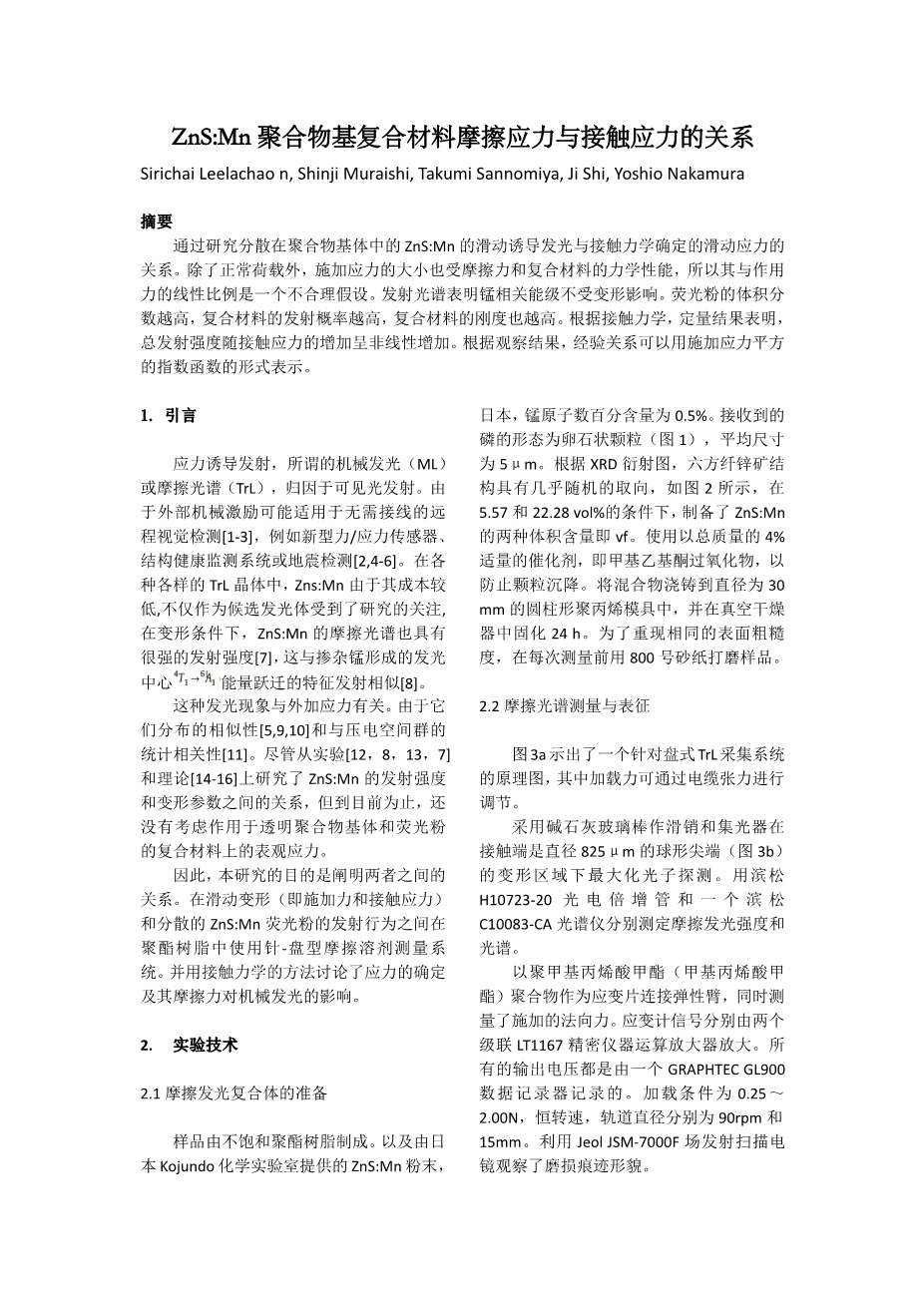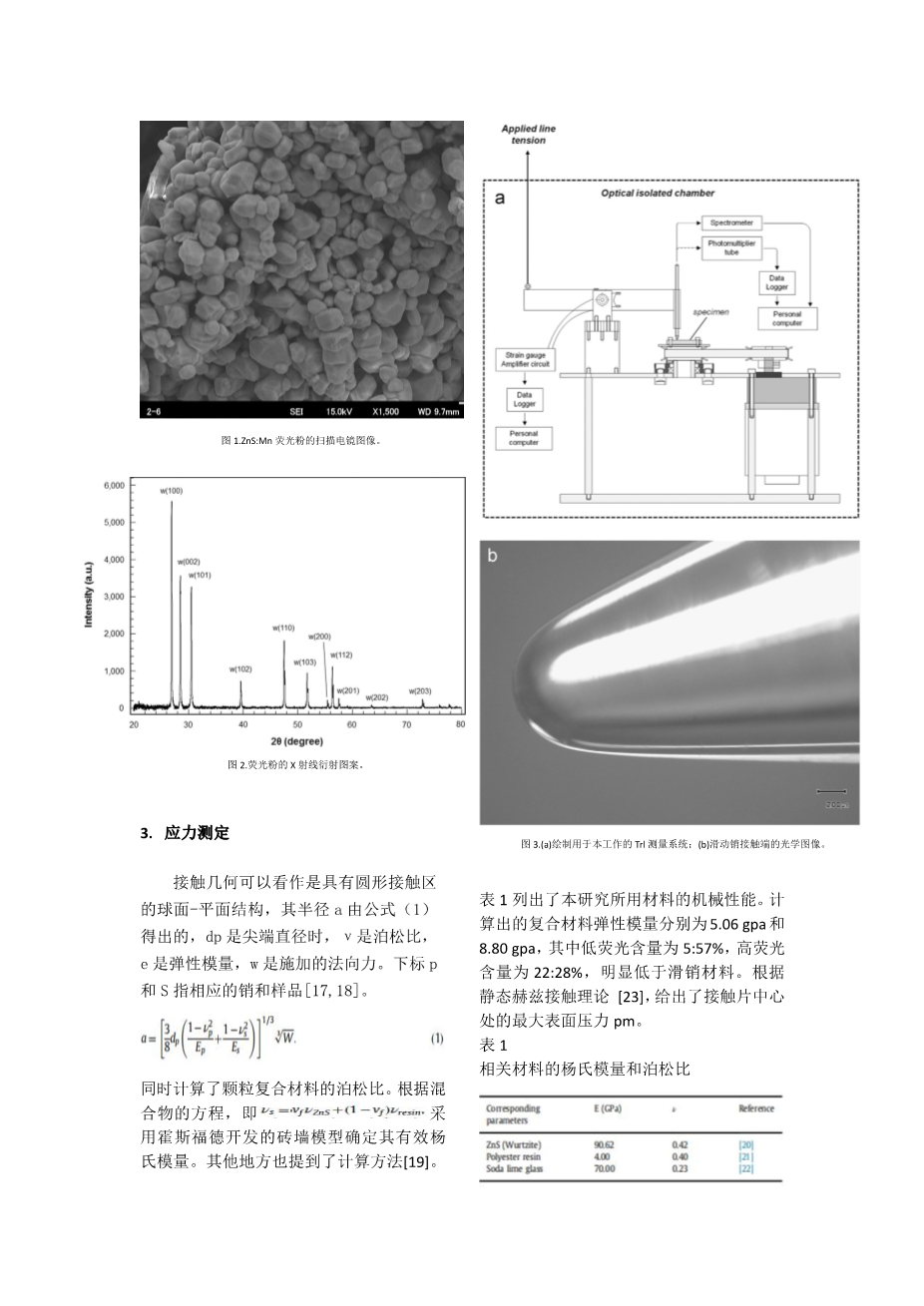|ZnS薄膜制备及性能研究外文翻译资料
2022-12-18 15:42:17
Journal of Luminescence 170 (2016) 24–29
Contents lists available at ScienceDirect
Journal of Luminescence
journal homepage: www.elsevier.com/locate/jlumin
Correlation of triboluminescence and contact stresses in ZnS: Mn/polymeric matrix composite
Sirichai Leelachao n, Shinji Muraishi, Takumi Sannomiya, Ji Shi, Yoshio Nakamura
Department of Metallurgy and Ceramics Science, Tokyo Institute of Technology, 2-12-1 Ookayama, Meguro-ku, Tokyo 152-8550, Japan
a r t i c l e i n f o
Article history:
Received 14 July 2015 Received in revised form 18 August 2015
Accepted 7 October 2015
Available online 22 October 2015
Keywords: Mechanoluminescence ZnS-based phosphors Composite materials
Contact mechanics
a b s t r a c t
A relationship between sliding-induced light emission of ZnS:Mn dispersed in polymer matrix and sliding stress determined by using contact mechanics is investigated. In addition to normal loads, the magnitude of exerting stress is also controlled by frictional force and mechanical properties of the composite so that its linear proportion to the applied force is an imprudent assumption. Emission spectra suggest that manganese-associated energy levels are not influenced by deformation. Not only is the emission probability increased but also the stiffness of the composite is enhanced by higher volume fraction of the phosphors. In accordance with contact mechanics, the quantitative results show that a total emission intensity increases non-linearly with contacting stress. Based on the observations, an empirical relationship might be expressed in the form of an exponential function of a square of the exerting stress.
amp; 2015 Elsevier B.V. All rights reserved.
- Introduction
Stress-induced emission, so-called mechanoluminescence (ML) or triboluminescence (TrL), is ascribed to a visible light emission due to external mechanical excitations [1–3] which may be applicable to remote visual detection without wiring such as novel force/stress sensors, structural health monitoring systems or earthquake detections [2,4–6]. Of the vast variety of TrL crystals, ZnS:Mn has received research attentions as the candidate lumi- nophors, not only because of its inexpensiveness, but also its intense emission intensity when subjected to a deformation [7]. Triboluminescence spectrum of ZnS:Mn was reported as being
stress, and an emission behavior of ZnS:Mn phosphors dispersed in polyester resin using a pin-on-disc type triboluminescence measuring system. Stress determination and the influence of experimental parameters such as friction force on mechan- oluminescence are also discussed by means of contact mechanics.
-
Experimental techniques
- Triboluminescent composite preparations
similar to a characteristic emission of 4T -6A
1
1
energy transition
Samples were fabricated from an unsaturated polyester resin
of luminescence centers created by doping manganese [8].
Such luminescence is suggested to relate with applied stress due to the resemblance of their distribution [5,9,10] and the sta- tistical correlation to piezoelectric space groups [11]. Although a relationship between emission intensity and deformational para- meters of ZnS:Mn has been investigated both experimentally [12,8,13,7] and theoretically [14–16], so far, an apparent stress acting on a composite of a transparent polymer matrix and the phosphors has not been taken into consideration.
Hence, the objective of the study is to elucidate the relationship between sliding deformations, i.e. applied force and contacting
n Corresponding author.
E-mail address: sirichai.lee@gmail.com (S. Leelachao).
and ZnS:Mn powders, provided by Kojundo Chemical Laboratory, Japan, at 0.5 at% manganese concentration. Morphology of as- received phosphors is pebble-like particles (Fig. 1) with an average size of 5 mu;m. According to XRD diffraction patterns, a hexagonal
wurtzite structure with nearly random orientation, as shown in Fig. 2. Two volumetric contents of ZnS:Mn, denoted as vf, were prepared at 5.57 and 22.28 vol%. A moderate amount of the cata- lyst, i.e. methyl ethyl ketone peroxide, at 4% of the total mass was used for preventing particle sedimentation. The mixture was cast into a cylindrical polypropylene mold with a diameter of 30 mm and cured in an evacuated desiccator for 24 h. To reproduce the identical surface roughness, the sample was polished with a 800- grit abrasive paper prior to each measurement.
http://dx.doi.org/10.1016/j.jlumin.2015.10.009
0022-2313/amp; 2015 Elsevier B.V. All rights rese
剩余内容已隐藏,支付完成后下载完整资料


英语译文共 6 页,剩余内容已隐藏,支付完成后下载完整资料
资料编号:[20177],资料为PDF文档或Word文档,PDF文档可免费转换为Word




